Support Green New Life, Revive Wildlife
2015.10 (Issue No.280)
Preface
Pheasant-tailed Jacana is listed by the Wildlife Conservation Act as a rare and valuable wild animal. The species is a rare sedentary fowl with a few migratory varieties. The bird nests in wetlands and artificial pools abundant in floating-leaved plants such as the water chestnut; hence it is also commonly known as the “Water Chestnut Bird” which is one of the farmland ecosystem representative animals typical of Taiwan. Although in Taiwan the majority of this species is resident, after mating season the birds would congregate at swamps not far from their breeding area.
In the 1990s, the Taiwan High Speed Rail planned route happened to cut through important pheasant-tailed jacana habitats at Hulubi and Deyuanbi in Guantian, Tainan. The Environmental Impact Assessment Committee subsequently decided that construction is allowed to begin only after 15 hectares of land be reserved as jacana habitat. Therefore, Taiwan High Speed Rail Corporation, Bureau of High Speed Rail, and Tainan County Government (presently Tainan City Government) jointly leased 15 hectares of land from Taiwan Sugar Corporation’s Longtian Farm in Guantian and established the “Pheasant-tailed Jacana Restoration Area”. In addition to providing subsidies to local governments for carrying out jacana nest subsidies following the Pheasant-tailed Jacana Conservation Reward Program, the Forestry Bureau is also working closely with associations such as Wetlands Taiwan and Bird Societies on the implementation of Jacana Conservation Programs in order to create suitable environments favorable to the wellbeing and restoration of the jacana population. In 2007, the “Pheasant-tailed Jacana Restoration Area” was renamed “Pheasant-tailed Jacana Ecological Education Park” where educational activities focusing on wetlands are carried out.
Every November, the flooded post-harvest water chestnut fields are the favorite locations for jacanas to rest and forage. However, most farmers would reclaim these fields from mid-December to the end of January to cultivate rice. In recent years, farmers prefer the low-cost direct seeding over the traditional seedling planting method. However, in order to protect the seeds from pests, rodents, and sparrows, some farmers would mix seeds with pesticide or place poison baits which had caused the deaths of unsuspecting jacanas and other aquatic birds instead. According to the Park’s investigation, 85 pheasant-tailed jacanas have been poisoned to death between December 2009 to February 2010. The incident triggered public outrage and the Forestry Bureau decided that marking an ecological education park for their conservation is not enough. In order to fully protect this endangered species, these threats against protected species must be eliminated.
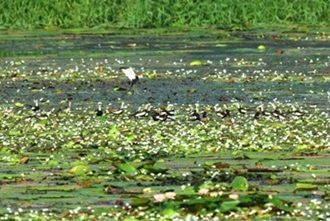
Successful jacana restoration at Pheasant-tailed Jacana Ecological Park.
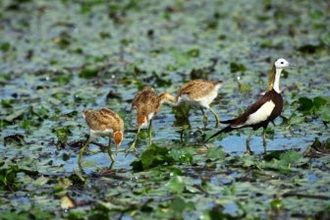
Pheasant-tailed jacana foraging with her offspring.
Jacana conservation begins with improvement of farmland ecology
Although environmentalists lament the loss of pheasant-tailed jacanas to accidental poisoning, they also urge the public not to condemn the farmers for the deaths of these birds since their original intention was to protect the seeds and the poison was not specifically targeted towards these birds. These unfortunate incidents made us understand that it is possible to achieve a win-win situation for nature conservation and agriculture production only when a balance between creating jacana-friendly farmland eco-environment and securing agricultural productivity can be reached.
Therefore the Forestry Bureau and the Tse-Xin Organic Agriculture Foundation (TOAF) jointly implemented the “Guantian Pheasant-tailed Jacana and Protected Wildlife Farmland Habitat Green Conservation Management Project”in 2010. The TOAF signed the “Guantian Pheasant-tailed Jacana Habitat Cooperation Agreement” with farmers in Guantian region which encourages farmers to stop using poisonous rice seeds during spring cultivation period and adopt methods that are friendly to the jacana habitat instead, so as to ensure a safe winter foraging environment for the jacanas. In that same year, 18 farmers signed the agreement with a total of 18.3 hectares of farmland area. In 2011 there were 40 farmers in the program with a total of 32.6 hectares. As of 2015, the number of farmers who joined the cause is 57, with a total farmland area of 47.4 hectares.
According to studies conducted by the Wild Bird Society of Tainan, in 1999 the number of pheasant-tailed jacana nests was 52 and there were 57 juveniles which had fully grown into adults. In 2014, 577 nests were accounted for and the number of juveniles that grew into adults was 926 (Fig. 1). Census in December recorded 707 wintering individuals, which saw an increase of 90 individuals compared to 2013. The results demonstrate that sustainable and friendly wintering environments have been successfully created for the jacanas. They further validate the fact that the jacana population in Tainan area has been enjoying a steady growth due to the environmentally friendly farming techniques.

Fig. 1: Tainan region pheasant-tailed jacana procreation monitoring chart

Footprints Market - Many environmentally conscious farmers join the line of conservation.
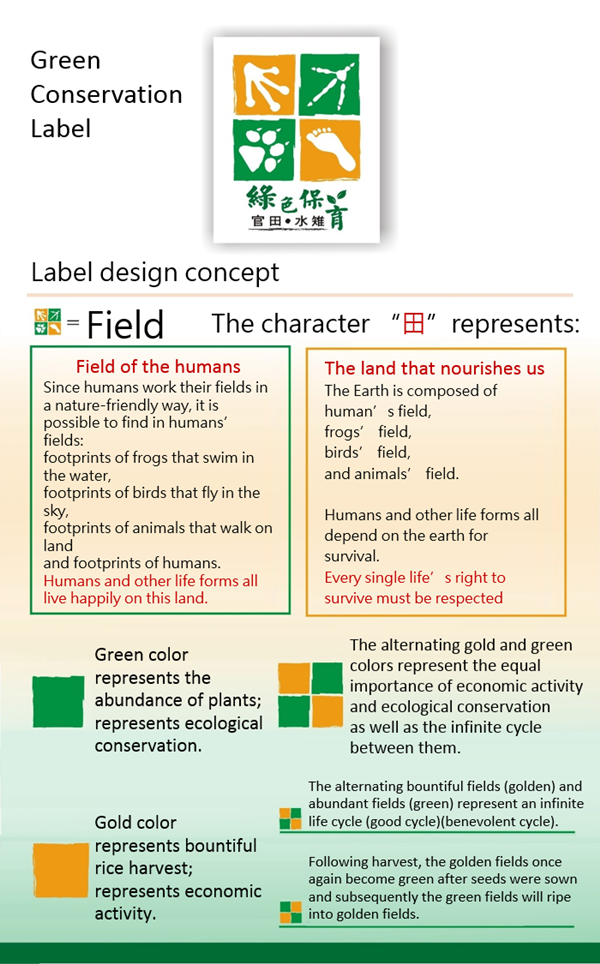
Fig. 2: The design concept of the Green Conservation Label
Green conservation certification mechanism
In order to establish a complete certification mechanism for the Green Conservation Label (GCL), the TOAF published the Green Conservation Agro-product (GCAP) Management Manual as the core standard for inspections and regulations. The manual includes documents such as application procedures, GC agro-product manufacturing and ecology conservation measures, GCL usage regulation, GCAP application form, GC processing and packing application form, among others at the disposition of the farmers for the application of Green Conservation Label. In addition, the Foundation has established the “GC Product Manufacturing Standard” which offer detailed explanations of items such as GC production principles; soil fertility and crop nutrition standard; crop species and seeds standard; crop pest and weed management standard; wild crop production and management; factory area hazardous biological entities management standard, among others. Farmers are encouraged to consult these standards and follow suit in order to ensure the effective implementation of GC production model.
The criteria for issuing the GCL are: a) Free of any pesticide, herbicide, or chemical fertilizer. b) No residual pesticide can be detected on the final agro-product. c) Farmland must be a rich ecosystem which provides a suitable environment where protected species can forage, procreate, and raise their youth.
In addition to providing cultivation expense subsidies to farmers whose crop fields are within areas marked as “hot spots” of jacana poisoning, the TOAF has also promoted the concept of organic farming by encouraging farmers to adopt organic production. However, since the farmlands that choose to participate in the organic program are dispersed throughout the region, there is a high chance their agro-products might fail the organic certification inspection due to their neighboring farmlands that still use the traditional farming methods. On the other hand, the authorities encourage farmers to create jacana-friendly habitats by adopting pesticide and chemical fertilizer-free farming techniques. These farmlands are named “Green Conservation Fields”. This GC concept would elevate the market value of the products as well as guaranteed pricing and distribution after farmers make the transition towards organic water chestnut farming. Therefore, more and more water chestnut farmers are willing to switch to jacana-friendly cultivation techniques. In order to facilitate the recognition of these GC agro-products for the consumers, the TOAF developed the Green Conservation Label (GCL) as identification.
Promotion of the Green Conservation Label
The TOAF began promoting the Green Conservation Label in 2011 and encouraged Guantian region farmers whose farmlands are located within important jacana wintering areas to adopt friendly farming techniques and stop using chemical pesticides and fertilizers. There were only 7 water chestnut farmers with a total of 3.37 hectares of farmland who signed up for the program that same year. Subsequent cultivation of rice was 3.22 hectares. The numbers for the year 2015 have increased to 27 participating farmers and 21.55 hectares of farmland.
In 2012, the TOAF hoped to gradually guide most farmers to change farming techniques and extend the concept to protected wildlife restoration works in other regions. All products that meet the aforementioned three requirements may submit the application for the Green Conservation Label to the TOAF. In addition to the jacana conservation work undergoing in Tainan City’s Guantian Dist., farmers from other regions throughout the country such as Gongliao Dist., and Pinglin Dist. in New Taipei City, Changhwa County, Nantou County, Yunlin County, Hualian County, Kaohsiung City, and Taitung County have also joined the initiative and applied for the GCL. As of 2015, there are 186 farmers who joined the program with a total of 213.91 hectares of farmland. Thus far, only the offshore island regions and Taichung City remain void of any registered participating farmer. The crops produced by these GC farms are mainly water chestnut, rice, tea, and peach among others. The species of animals marked for conservation are: pheasant-tailed jacana, Taiwan bulbul, fairy pitta, maroon oriole, ring-necked pheasant, crested serpent eagle, mountain scops owl, euploea butterfly, golden birdwing butterfly, green tree frog, two-striped grass frog, farmland tree frog, giant water bugs, Chinese box turtle, moltrecht's minnow, crab-eating mongoose, masked palm civet, and pangolins among other 35 species. As for the products that have been successfully developed for consumers are the organic water chestnuts and Lingsiang rice from Tainan which benefit jacana conservation, the Hoho Rice from New Taipei City’s Gongliao Dist. which benefits crab-eating mongoose conservation, the organic tea from Pinglin which benefits green tree frog conservation, and the organic pineapple from Hualian County which benefits ring-necked pheasant conservation.

Guantian wetland companion agro-series: water chestnut.

Guantian wetland companion agro-series: Lingsiang rice.
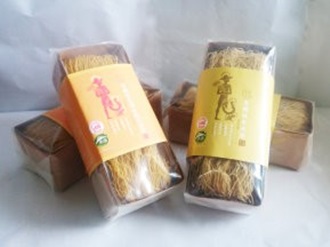
Guantian wetland companion agro-series: organic rice vermicelli product line (wholegrain and pumpkin).
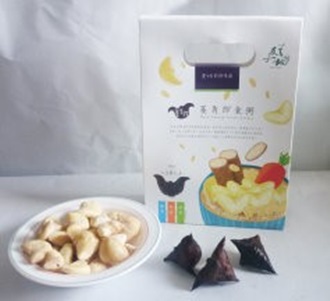
Guantian wetland companion agro-series: water chestnut instant porridge.

Guantian wetland companion agro-series: water chestnut tea bags.
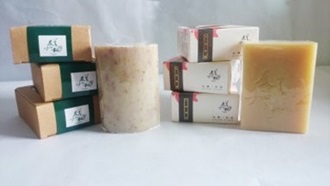
Guantian wetland companion agro-series: water chestnut soap.
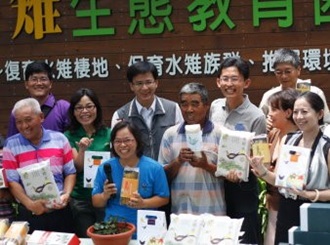
Enterprises join the Guantian Wetland Companion Conservation Program: press conference.
Innovative green conservation value
After 5 years of implementation, the TOAF found out that even though many environmentally conscious farmers refrain from using pesticides and chemical fertilizers, their farmlands do not seem to attract wild animals on the conservation list possibly due to different geographical locations of their lands. However, they do host many varieties of farmland organisms which reflect the level of ecological friendliness of the land. Therefore, the TOAF decided to add “special animals” such as the giant water bug and the euploea butterfly to the list. Although they are not protected species, their presence in the field indicates that the farmland where they are found meets the requirement of Green Conservation and therefore, the farmer is eligible for the application of GCL. In order to recruit more environmentally friendly farmers and encourage more collective efforts to improve farmland ecology, in April 2015 the TOAF added concepts such as “Indicator species”, “Commemorative species”, and “Habitat creation”.
The GC products developed and produced in Guantian region between 2011 and 2014 are water chestnuts, unhusked water chestnuts, water chestnut tea, Lingsiang rice (white and wholegrain), 100% natural wholegrain rice vermicelli, water chestnut rice pudding, Lingsiangnan rice dumpling, and water chestnut cake. Most of these products are sold in Leezen Shops or other organic retail stores.
In September 2015, Forestry Bureau, Wild Bird Society of Tainan, Chinese Wild Bird Federation, and Earth Friend Organics teamed up to jointly promote the Pheasant-tailed Jacana Green Conservation Program. These entities worked together in transforming the popular water chestnut from Guantian into diverse products such as the unique water chestnut jelly rich in polyphenol (an antioxidant)- the safe and delicious Lingsiang jelly. Not only the consumers have more water chestnut options to choose from but farmers can obtain more profit from the program and thus increase their willingness to switch to friendly farming giving jacanas more spacious habitat. 10% of the revenue from Lingsiang jelly sales would be donated by enterprises to the pheasant-tailed jacana and habitat conservation, making the purchase of this product a meaningful one.

The Lingsiang jelly was revealed at a press conference.
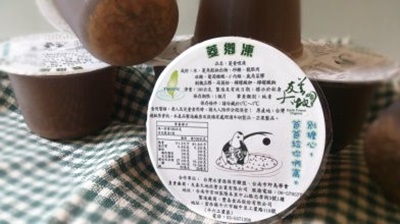
The Lingsiang jelly is rich in polyphenol.
Balance between production and ecology leads to sustainable life
Prof. Sung, Bin-min of National Dong Hwa University said, “For every bowl of friendly farming rice you eat, you save the lives of 2 frogs, which in turn means that there is clean water. This pure water ends up in the ocean and keeps it unpolluted. Ultimately this will result in safe seafood sources. The Earth moves in a full positive circle.”
Friendly Cultivation Agriculture is the production model for a sustainable community development. It can conserve soil and bio-resources on the “ecology” level, while the cooperative community marketing can increase profit on the “life” level. Through the purchase of healthy agro-products consumers not only encourage farmers to adopt friendly farming in favor of wildlife conservation, but also enjoy safe and healthy products which are beneficial to the body and quality of life. This reflects the fact that it is possible to achieve economic development through sustainable production, life, and ecology.
Under the support of Forestry Bureau of COA, the Pheasant-tailed Jacana Ecological Education Park and Earth Friend Organics jointly set in motion the “Guantian Green Conservation Agriculture Feedback Program” which encourages friendly farming. Each time a consumer purchases GC product or friendly cultivated agro-product produced in Guantian on-line, the program sets 15% of the revenue aside to give back to the farmers and to be used for other purposes such as recruiting new-blood and serve as emergency aid fund. Close to NT$ 50,000 from the first month revenue was awarded to farmers. This demonstrated that with the rise of conservation awareness, consumers are willing to support the ecological conservation cause by purchasing healthy agro-products.
There are many farmers in Taiwan who care about the environment and the ecology. Even though their agro-products are completely safe and totally friendly to the environment, they are still the minority and weak against challenges, such as high cost, limited production output, unattractive product appearance, and pressure from sales outcomes. Therefore, in order for them to be able to maintain sustainable operation while dedicating to farmland ecological conservation, the Forestry Bureau and the TOAF sought the cooperation of the National Taiwan Museum, Ministry of Culture to exhibit the Bureau’s achievements in Green Conservation at the Museum’s Nanmen Park as well as to organize the “Footprints in the Field Farmers Market” every Saturday. The exhibition and the market not only offer residents of the Greater Taipei area a place to purchase environmentally friendly fresh produce, they also offer consumers the opportunity to keeping a clean environment for precious organisms endemic to Taiwan while savoring agro-products produced by friendly farming. Everyone is welcome to support wildlife conservation by joining the green consumer movement which surely will create a better environment for everyone on this Earth.
